'Morality is not on our side.'. by Ze'ev Maoz, professor of political science at Tel Aviv university.
http://www.haaretz.com/hasen/spages/742257.html
Wednesday, August 30, 2006
Monday, August 21, 2006
A Few Good Pieces
from a few recent openings I happened to catch, during the few times that I had a camera with me. sorry but I did not take note of the artist's names... prolly should but to me it's the work and the idea that are important.
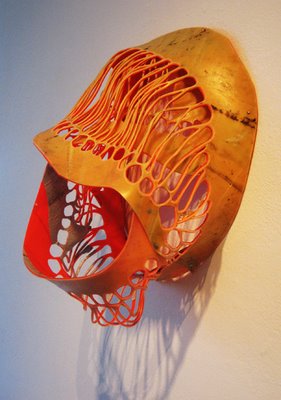
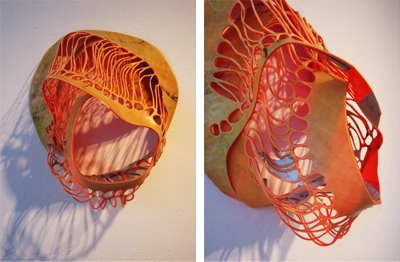 this orange cocoon-like bio-morphic sculpture used to be a traffic cone. there was also a painting made with pieces of traffic cones, but it was not nearly as successful. it casts a beautiful shadow on the wall (sorry I didn't get a good picture of that). I am soooooo into ordinary things becoming strange.
this orange cocoon-like bio-morphic sculpture used to be a traffic cone. there was also a painting made with pieces of traffic cones, but it was not nearly as successful. it casts a beautiful shadow on the wall (sorry I didn't get a good picture of that). I am soooooo into ordinary things becoming strange.
this and the next hair piece are both from a show partly curated by Tim Hawkinson (can't really go wrong with this guy. ever)
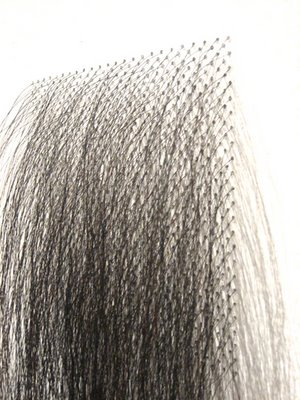
 in case you can't tell what it is - a perfect square shaped grid made of tiny holes drilled into the gallery wall, and out of each hole a single piece of what appears to be human hair sticks out. the height is about the length of a girl's long-ish, past shoulder-length hair. definitely some attraction/repulsion thing going on. except the attraction is more like an obsessive compulsive's (at best. a serial killer's at worst) idea of attraction. guess it's more strange/alarming/creepy/repulsive than attractive. I guess this falls easily in the camp of post-minimalism, where rigid (often geometric) formalism is problemized - in this case, by a biological system.
in case you can't tell what it is - a perfect square shaped grid made of tiny holes drilled into the gallery wall, and out of each hole a single piece of what appears to be human hair sticks out. the height is about the length of a girl's long-ish, past shoulder-length hair. definitely some attraction/repulsion thing going on. except the attraction is more like an obsessive compulsive's (at best. a serial killer's at worst) idea of attraction. guess it's more strange/alarming/creepy/repulsive than attractive. I guess this falls easily in the camp of post-minimalism, where rigid (often geometric) formalism is problemized - in this case, by a biological system.

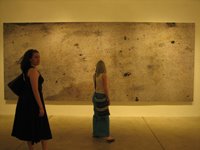 absolutely love this. a giant photo of the areal view of a piece of cement sidewalk. I saw it as an abstract painting at first, and then noticed the couple of cigarrette butts and like, a penny. reminds me of "The Washing of a School Yard", a film by Charles and Ray Eames - exact what it sounds like - areal view still shot of foam and water spreading and washing over the cement of a school yard, forming beautiful psychedelic patterns.
absolutely love this. a giant photo of the areal view of a piece of cement sidewalk. I saw it as an abstract painting at first, and then noticed the couple of cigarrette butts and like, a penny. reminds me of "The Washing of a School Yard", a film by Charles and Ray Eames - exact what it sounds like - areal view still shot of foam and water spreading and washing over the cement of a school yard, forming beautiful psychedelic patterns.


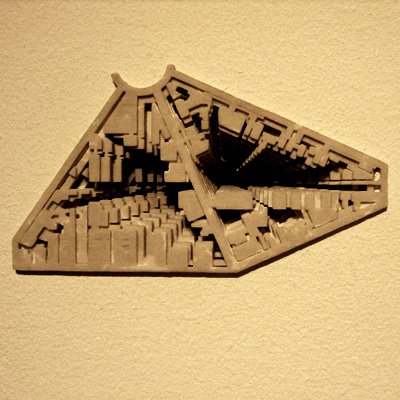 this is one of the only saving graces of the first installment of the Super-Sonic show (entirely arbituary, stupid name), which was comprised of the work of 8 MFA programs of the artschools in the LA area. includes Art Center, Cal Arts, Otis, etc, etc. the second installment did not have a saving grace.
this is one of the only saving graces of the first installment of the Super-Sonic show (entirely arbituary, stupid name), which was comprised of the work of 8 MFA programs of the artschools in the LA area. includes Art Center, Cal Arts, Otis, etc, etc. the second installment did not have a saving grace.
these are about the size of your palm, and appear to be made of rubber, encased at eye-level into the gallery wall; its concavity is only maybe an inch or 2 deep, but the receding perspective gives it the illusion of depth. there are so many ways to look at this that I'm not going to go into it - maybe it's enough to just say that they are pretty fucking cool.

 this orange cocoon-like bio-morphic sculpture used to be a traffic cone. there was also a painting made with pieces of traffic cones, but it was not nearly as successful. it casts a beautiful shadow on the wall (sorry I didn't get a good picture of that). I am soooooo into ordinary things becoming strange.
this orange cocoon-like bio-morphic sculpture used to be a traffic cone. there was also a painting made with pieces of traffic cones, but it was not nearly as successful. it casts a beautiful shadow on the wall (sorry I didn't get a good picture of that). I am soooooo into ordinary things becoming strange. this and the next hair piece are both from a show partly curated by Tim Hawkinson (can't really go wrong with this guy. ever)

 in case you can't tell what it is - a perfect square shaped grid made of tiny holes drilled into the gallery wall, and out of each hole a single piece of what appears to be human hair sticks out. the height is about the length of a girl's long-ish, past shoulder-length hair. definitely some attraction/repulsion thing going on. except the attraction is more like an obsessive compulsive's (at best. a serial killer's at worst) idea of attraction. guess it's more strange/alarming/creepy/repulsive than attractive. I guess this falls easily in the camp of post-minimalism, where rigid (often geometric) formalism is problemized - in this case, by a biological system.
in case you can't tell what it is - a perfect square shaped grid made of tiny holes drilled into the gallery wall, and out of each hole a single piece of what appears to be human hair sticks out. the height is about the length of a girl's long-ish, past shoulder-length hair. definitely some attraction/repulsion thing going on. except the attraction is more like an obsessive compulsive's (at best. a serial killer's at worst) idea of attraction. guess it's more strange/alarming/creepy/repulsive than attractive. I guess this falls easily in the camp of post-minimalism, where rigid (often geometric) formalism is problemized - in this case, by a biological system.
 absolutely love this. a giant photo of the areal view of a piece of cement sidewalk. I saw it as an abstract painting at first, and then noticed the couple of cigarrette butts and like, a penny. reminds me of "The Washing of a School Yard", a film by Charles and Ray Eames - exact what it sounds like - areal view still shot of foam and water spreading and washing over the cement of a school yard, forming beautiful psychedelic patterns.
absolutely love this. a giant photo of the areal view of a piece of cement sidewalk. I saw it as an abstract painting at first, and then noticed the couple of cigarrette butts and like, a penny. reminds me of "The Washing of a School Yard", a film by Charles and Ray Eames - exact what it sounds like - areal view still shot of foam and water spreading and washing over the cement of a school yard, forming beautiful psychedelic patterns. 

 this is one of the only saving graces of the first installment of the Super-Sonic show (entirely arbituary, stupid name), which was comprised of the work of 8 MFA programs of the artschools in the LA area. includes Art Center, Cal Arts, Otis, etc, etc. the second installment did not have a saving grace.
this is one of the only saving graces of the first installment of the Super-Sonic show (entirely arbituary, stupid name), which was comprised of the work of 8 MFA programs of the artschools in the LA area. includes Art Center, Cal Arts, Otis, etc, etc. the second installment did not have a saving grace. these are about the size of your palm, and appear to be made of rubber, encased at eye-level into the gallery wall; its concavity is only maybe an inch or 2 deep, but the receding perspective gives it the illusion of depth. there are so many ways to look at this that I'm not going to go into it - maybe it's enough to just say that they are pretty fucking cool.
Wednesday, August 09, 2006
Against Pluralism
 "Against Pluralism" is an essay by Hal Foster in the 1980s in which he makes the case that the current "all is permitted, nothing means jack-shit" supermarket-mentality of the art world is falsely liberating; that it is an illusory freedom; that it actually cloaks sinister conservatism and even fascism just beneath the variety-show surface. an image of art finally and completely succumbing to consumerism, losing all of its vitality, much less subversive power.
"Against Pluralism" is an essay by Hal Foster in the 1980s in which he makes the case that the current "all is permitted, nothing means jack-shit" supermarket-mentality of the art world is falsely liberating; that it is an illusory freedom; that it actually cloaks sinister conservatism and even fascism just beneath the variety-show surface. an image of art finally and completely succumbing to consumerism, losing all of its vitality, much less subversive power.some may consider Hal to be a rigid old modernist who needs to "lighten up", but to me this piece of writing is as crucial as ever now in 2006:
my mind keeps going there when I'm in some new gallery space staring at paintings that look like T-shirt graphics, or photos of drunk people, or installations involving hundreds of ball-point pen portraits drawn on bar napkins...
it's ironic innit? the collapse of cohesive discourse in the academic establishment signaling fascism... but it kind of makes sense to me.
my through and through populist friends dissagree completely. To these anti-academics who are quick to shout "Elitism" and "Ivory Tower", the current "whatever it's all good" art world is an image of the triumph of the common man...
but is it?
from the second part of Against Pluralism entitled "A state of Grace?":
"... (Pluralism) is a situation that grants a kind of equivalence; art of many sorts is made to seem more or less equal - equally (un)important. Art becomes an arena not of dialectical dialogue but of vested interests, of licensed sects: in lieu of culture we have cults. The result is an eccentricity that leads, in art as in politics, to a new conformity: pluralism as an institution.
Posed as a freedom to choose, the pluralist position plays right into the ideology of the "free market" ... Indeed, the freedom of art today is announced by some as the "end of ideology" and the "end of the dialectic"- an announcement that, however naive, makes this ideology all the more devious. In effect, the demise of one style (e.e., minimalism) or one type of criticism (e.e., formalism) or even one period (e.g., late modernism) tends to be mistaken for the death of all such formulations. Such a death is vital to pluralism: for with ideology and dialectic somehow slain, we enter a state that seems like grace, a state that allows, extraordinarily, for all styles - pluralism. Such innocence in the face of history implies a serious misconstrual of the historicity of art and society. It also implies a failure of criticism.
When formalism prevailed, art tended to be self-critical. ... When formalism fell, even this attitude was largely lost. Free before of other discourses, art now seemed free from its own discourse. and soon it appeared that all criticism, once so crucial to art practice, had lost its cogency. ... We are free - of what, we think we know. But where are we left? The present in art has a strange form, at once full and empty, and a strange tense, a sort of neo-now moment of "arriere-avant-gardism." Many artists borrow promiscuously from both historical and modern art. But these references rarely engage the source - let alone the present - deeply. And the typical artist is often "foot-loose in time, culture and metaphor": a dilettante because he thinks that , as he entertains the past, he is beyond the exigency of the present; a dunce because he assumes a delusion; and a dangling man because historical moment - our present problematic - is lost.
Modern art ENGAGED historical forms, often in order to deconstruct them. Our new art tends to ASSUME historical forms - out of context and reified. Parodic or straight, these quotations plead for the importance, even the traditional status, of the new art. In certain quarters this is seen as a "return to history"; but it is in fact a profoundly ahistorical enterprise, and the result is often "aesthetic pleasure as false consciousness, or vice versa".
This "return to history" is ahistorical for three reasons: the context of history is disregarded, its continuum is disavowed, and conflictual forms of art and modes of production are falsely resolved in pastiche. Neither the specificity of the past nor the necessity of the present is heeded. Such a disregard makes the return to history also seem to be a liberation from history. And today many artists do feel that, free of history, they are able to use it as they wish. ...
To be unaware of historical or social limits is not to be free of them; one is all the more subjected. ... So it is that the freedom of art today is forced (both false and compelled): a willful naivete that masquerades as jouissance, a promiscuity misconceived as pleasure. Marcuse noted how the old tactics of (sexual) liberation, so subversive in a society of production, have come to serve the status quo of our society of consumption: he termed this "repressive desublimation." Similarly, pluralism in art signals a form of tolerance that does not threaten the status quo.
... Art became skittishly stylish - everyone had to be different... in the same way. ... as Adorno remarked, "the official culture's pretense of individualism...necessarily increases in proportion to the liquidation of the individual." Meanwhile, the conventions of art are not in decline but in extraordinary expansion. ...
... an art of "effect"... cannot escape its own condition of hysterical futility. It strains for effects only to degenerate into postures, and these postures have no relief: the emerge flat and ephemeral...
... The victim here is not the historicist model of an autonomous, causal line of "influence," but rather the dialectical model that demands radical, materialist innovation. It is this history that tends to be denied, only to be replaced by history as a monument (or ruin) - a store of styles, symbols, etc., to plunder... Rather than explore this condition of cliched styles and prescriptive codes (as Barthes and Derrida have done), many artists today merely exploit it, and either produce images that are easy to consume or indulge in stylistic references - often in such a way that the past is entertained precisely as publicity. The artist innocent today is a dilettante who, bound to modernist irony, flaunts alienation as if it were freedom. "
___________
this essay has made me realize that in recently years, just as often as I have been disgusted with so much crap being shown, that I have been too easily seduced by the superficially tasteful and pretty.
what's more, I realize that I too have delighted in the irresponsible plunder of history, and the thoughtless mix'n'match of signifiers for mere effect.
I too have felt the "illusory freedom" afforded by this state of affairs - "hey look I can just put these Victorian patterns on top of these images of break-dancers and it looks cool and it's OK!"
Wednesday, August 02, 2006
conversation a designer has with himself
on a regular basis:
"it's abitrary"
"it looks cool"
"but it's abitrary innit"
"but it looks awesome!"
"is there any reason for it being there?"
"because it looks fucking great that's why!"
"besides that one"
"it's sexy! people will like it!"
"it's meaningless."
"who cares!"
"still abitrary."
"but it looks so good..."
...
"it's abitrary"
"it looks cool"
"but it's abitrary innit"
"but it looks awesome!"
"is there any reason for it being there?"
"because it looks fucking great that's why!"
"besides that one"
"it's sexy! people will like it!"
"it's meaningless."
"who cares!"
"still abitrary."
"but it looks so good..."
...
Tuesday, August 01, 2006
Against Subjectivity
 When Alexander the Great told Plato that there is nothing bigger in the world than his kingdom, Plato replied "but of course there is!" Confused, Alexander asks "what is that?" and Plato replied: "my eyelids! because when I close my eyes, your entire kingdom is covered up!"
When Alexander the Great told Plato that there is nothing bigger in the world than his kingdom, Plato replied "but of course there is!" Confused, Alexander asks "what is that?" and Plato replied: "my eyelids! because when I close my eyes, your entire kingdom is covered up!"Everything is relative, and the only reality is perception. This we know well.
But serious problems occur when an universal truth like this is blindly applied to specific human endeavor; and we come to the single most irritating remark anyone can make in regards to art:
"it's all subjective."
This mistake is often made by otherwise reasonable people, and is nothing short of lazy, irresponsible, and so unjust that it borders on being amoral in its carelessness.
what does it mean to make this blanket statement?
that all conversations about art are pointless because it's all personal likes and dislikes? that anything anyone ever makes, whether a lewd drawing in a public restroom or the Sistine Chapel, should be equally valued?
There are no absolutes, but with anything we humans do, there is one or more convincing sets of criteria with which to judge it. A plate of pasta can be judged on the quality of the noodles and the richness of the sauce. A hiphop track can be judged in terms of quality of production, dexterity of flow. and conceptual art can be judged by a combination of its economy, grace, originality, ingenuity, wit, contribution to discourse, profundity of its message, etc.
things can be only compared to other things within the same "genre", and judgement is more problematic and complex in some areas compared to others (conceptual art is more difficult than pasta), but none the less we use existing or invent new sets of criteria to determine the quality of man made things every day of our lives, and in most cases agree with what these sets of criteria include and how they function.
perhaps there is one over-arching criteria above all else: fitness to purpose. (if a thing does what it has proposed to do and does it well, then it is good.)
Sartre had this to say about it:
"Opinion" reduces all ideas to the level of "taste" and ofcourse all "tastes" are valid. it is what a hostess says when a discussion threatens to become unruly: 'you are all entitled to your OPINION, so everyone, shhhhhhh!'"
people who are anti my stance on this subject (including a few friends), who insist on absolute subjectivity (creepy parallel to the moral relativism of the neo-cons), will often accuse me of being an ego-centric fascist who thinks he can impose his own (priveledged, "educated", "western") values onto the entire world.
not so.
Because when I see contemporary Arabic Typography, look at a porceline vase from 4000 BC China, read a novel by Viginia Wolfe, listen to an 18th century Raga from India, use a piece of designer silverware from Sweden -- I perceive the same level of accomplishment - attention to detail, sophistication in simplicity, inventiveness, and resolution of formal elements into a finished, cohesive whole which is greater than the sum of the parts. (this incidentally may be a good definition of art)
And I do believe that to some extent, people all over the world of all times, of varying degrees of "education" (whatever that means), will feel the same way -- a well made thing is a well made thing, easy to tell from the badly made things.
Again, obviously nothing is absolute and there must be countless exceptions - due to cultural differences (Westerners love cheese and most of Asia thinks it is disgusting) or entirely different functional nature of the object (modern art), but the bigger picture remains the same.
so people please, you know who you are, stop saying this ridiculous thing... because not only does it make you seem utterly banal and moronic, but everytime you do, something in me dies.
Hello World
Different Waters is the music blog, and this one will be everything else: art, philosophy, poetry, politics, movies, personal accounts of strange or funny phenomenon, bad and good jokes, the behavioral patterns of wild Geese during mating season, and what ever else I god damn feel like writing about.
word.
word.
Subscribe to:
Posts (Atom)
